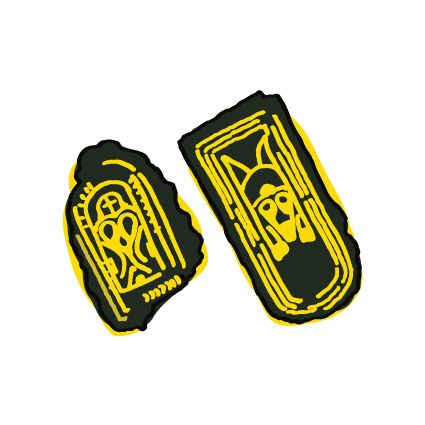
A vas övveretek, övgarnitúrák igen ritka leletek a Kárpát-medencei avar emlékanyagban. Ezek között is különlegességnek számítanak azok, amelyek veretein egykori készítőik emberi arcokat ábrázoltak. Az eddig ismert négy lelőhely és egy szórványdarab mellett Veszprém megye első ilyen típusú veretei Balatonudvari-Fövenyes temető 544. sírjából kerültek elő. Már találásukkor is sejteni lehetett, hogy a leletek különlegesek, de ekkor csupán egy csomó korrodált vasdarabnak tűntek, és csak restaurálás után derült ki, hogy a kisebb-nagyobb veretek ezüst-, aranyhuzalok, -lemezek segítségével tausírozással díszítettek. Közülük is a legszebbek azok, amelyek igen szép, finom kivitelű kis arcocskákat ábrázolnak. Ezek nemcsak mestermunkák, de az ábrázolt viseleti elemek alapján – fejfedők, ruharészletek – valószínűleg a közösség vagy egyén vallási hovatartozását is jelzik, esetleg liturgikus ruhadarabok ábrázolásai is lehetnek. Az övgarnitúra többi veretének geometrikus díszítései – akárcsak a pajzs alakú veretek körbe zárt keresztmotívuma – ugyancsak a keresztény szimbolikához való kötődést mutatják.
Az avar környezetben idegen veretsor a 7. század középső harmadában készülhetett. Ebben az időszakban hasonló díszek elsősorban a germánok (bajorok, alamannok) által lakott területeken jellemzőek, de szép számban a langobárdok által birtokolt Itáliában is megtalálhatók. Nagy valószínűséggel az előállító műhely vagy műhelyek is itt lehettek, innen juthattak el vagy kereskedelemi kapcsolatok, vagy akár betelepülő germánok révén az avar szállásterületre. Talán a sírban nyugvó is idegen származású volt, de mindezek ellenére az avar (pogány) hit előírásainak megfelelően temették el a 7. század végén, vagy a 7–8. század fordulóján.
S. dr. Perémi Ágota
régész
Erre haladjon tovább:
A nagyméretű álló vitrin bal oldalára rejtettük a kódot. Itt a madarak közt lévő mészbetétes kerámiáról mesélünk.
Iron belt fittings and belt sets are quite rare among the Avar relics of the Carpathian Basin. Even among these, the ones whose maker decorated the fittings with human face depictions. Beside the four known sites and one isolated fragment, the first fitting of this type was found in grave 544. of the Balatonudvari-Fövenyes graveyard. It could already be suspected at the time they were found, that these artifacts are special, but at that time, they seemed like a couple of corroded pieces of iron. Only after their restoration did it come to light that these fittings of various sizes were made with damascening, using wires and sheets of silver and gold. Among these, the most exquisite are the ones that depict finely detailed tiny faces.
Based on the depicted clothing items - headwear and garment details - these items are not just masterfully crafted, but most likely served as an indicator of the religious affiliation of the community or individual, they could even be depictions of liturgical garments. The geometrical decorations of the other belt fittings - just like the cross motif encased in a shield - are suggestive of connections to Christian symbolism.
The series of fittings that are foreign to the Avar environments, was presumably made in the middle third of the 7th century. Around this time, similar decorative elements were most common in the territories inhabited by Germanic peoples(Bavarian and Alamannic), however, this number is not insignificant in the Italian territories held by the Lambards either. There is a high probability that the manufacture or manufactures that produced these items were located in this region, and from here, through trade connections or the immigrating Germanic people, their wares ended up in the Avar inhabited territories. The person who rests in the grave might have also been a foreigner to the land, despite this notion, they were laid to rest according to the rules of the avar (pagan) faith, either at the end of the 7th century, or at the turn of the 7th and 8th centuries.
dr. Ágota S. Perémi
archeologist
Proceed to this:
We hid the code on the left side of the large display case. Here we talk about the lime-inlaid ceramic that is situated among birds.